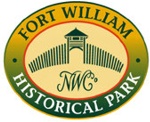Fort William Historical Park facts for kids
 |
|
| Former name | Old Fort William |
|---|---|
| Established | 1973 |
| Location | Thunder Bay, Ontario, Canada. |
| Type | Historical Park |
| Owner | Ontario Ministry of Tourism, Culture and Gaming |
| Public transit access | |
Fort William Historical Park is an exciting historical site in Thunder Bay, Ontario, Canada. It's a rebuilt version of an old fur trading post called Fort William, showing how it looked in 1815. This special park first opened its doors on July 3, 1973.
The park sits right by the Kaministiquia River at a spot called Point de Meuron. This location is a few kilometers upstream from where the original Fort William once stood. The original site is now part of the city of Thunder Bay. Point de Meuron itself is important because it was also home to an Hudson's Bay Company trading post.
Contents
History of Fort William
The North West Company was a big fur trading business. They had a main base at Grand Portage. After the American Revolutionary War, the land where Grand Portage was located became part of the United States. To avoid new taxes, the British and Canadian fur traders decided to move their main operations.
They chose a new spot north of the border, which became Fort William. This move helped them continue their fur trade without issues.
A Living History Experience
Fort William Historical Park is known as a living history site. This means you can see history come alive! Many old buildings have been rebuilt to show what the trading post was like. People dressed in historical costumes act out what life was like in Fort William in 1816.
In 1816, Fort William was not a town. It was a central hub for moving furs and supplies for the North West Company. Later, in 1821, it became a Hudson's Bay Company post. The original buildings of the fort were taken down in 1902. A special marker was placed there by the Thunder Bay Historical Society.
Fort William was much larger than most fur trading posts. It had more buildings and services. Today, Fort William Historical Park has 42 rebuilt buildings. It also has a rebuilt Ojibwa village and a small farm.
People of the Fur Trade
Historical interpreters at the park show the many different people and cultures involved in the fur trade. These include Scottish fur traders, who were often leaders. They sometimes married Native American women and had families living with them.
There were also French Canadian voyageurs and workers. They often formed relationships with Native women too. Native hunters and trappers were also a big part of the fur trade. The native people in the Fort William area were mostly Ojibwa, and they are shown by the interpreters.
In the early days, the North West Company's "winter partners" (fur traders who lived at the post) married into important native families. This helped make their alliances stronger. There were different groups in society. The fur traders and chiefs' daughters were one group. The workers and native women they married were another.
The children of the workers and native women often became the Métis ethnic group. They often continued in fur trapping. Children of fur traders and chiefs' daughters often received good English schooling. They also learned Native culture from their mothers' families. Many of them became important people in Canadian society.
Skilled Workers and Crafts
Fort William Historical Park has a community of skilled tradesmen. These include a blacksmith, tinsmith, carpenter, cooper, and birch bark canoe builder. They all make products using old methods and tools from the early 1800s.
Many of their crafts are not common today. For example, Fort William's canoe builder has made birch bark canoes for other Canadian historical sites. One of these is the Canadian Museum of Civilization.
The Great Rendezvous
Every summer, Fort William Historical Park hosts the "Great Rendezvous." This event recreates the yearly meeting of fur traders that happened at this central spot. People from all over Canada and the United States come to camp for the weekend. They take part in this exciting historical reenactment.
Legacy
On June 28, 1985, Canada Post released a stamp called 'Fort William, Ont.' It was part of the "Forts Across Canada Series." The stamps were designed by Rolf P. Harder.
Location and Travel
The park is located at the south end of King Road. King Road is off Broadway Avenue, two kilometers west of Highway 61. Thunder Bay Transit’s route 4 Neebing bus makes several trips to Fort William Historical Park on weekdays.
Amphitheatre
In 2008, the fort built a large outdoor amphitheatre. It is one of Canada's biggest outdoor entertainment places. The Amphitheatre can hold up to 50,000 people for events. It can even host several different events at the same time.
The Amphitheatre is used all year round. In winter, it can have six hockey ice surfaces. In summer, it can be a full-service campground for special events and concerts.
Affiliations
The museum works with several organizations. These include the CMA, CHIN, and Virtual Museum of Canada.
See also
- List of contemporary amphitheaters





